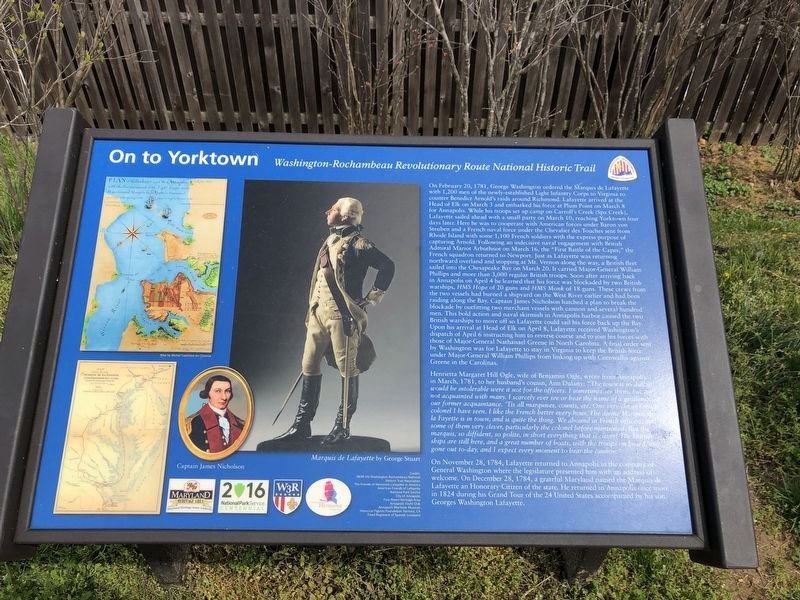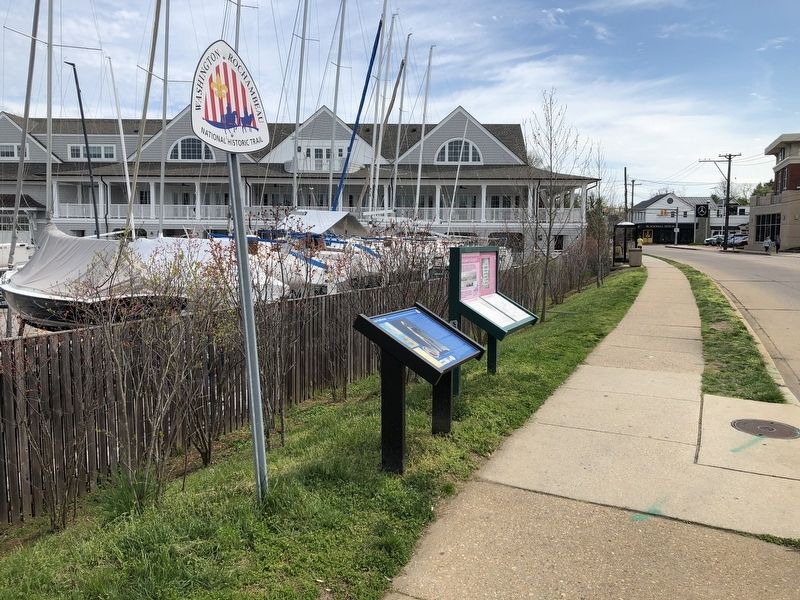Eastport in Annapolis in Anne Arundel County, Maryland — The American Northeast (Mid-Atlantic)
On to Yorktown
Washington-Rochambeau Revolutionary Route National Historic Trail
On February 20, 1781, George Washington ordered the Marquis de Lafayette with 1,200 men of the newly-established Light Infantry Corps to Virginia to counter Benedict Arnold's raids around Richmond. Lafayette arrived at the Head of Elk on March 3 and embarked his force at Plum Point on March 8 for Annapolis. While his troops set up camp on Carroll's Creek (Spa Creek), Lafayette sailed ahead with a small party on March 10, reaching Yorktown four days later. Here he was to cooperate with American forces under Baron von Steuben and a French naval force under the Chevalier de Touches sent from Rhode Island with some 1,100 French soldiers with the express purpose of capturing Arnold. Following an indecisive naval engagement with British Admiral Mariot Arbuthnot on March 16, the "First Battle of the Capes," the French squadron returned to Newport. Just as Lafayette was returning northward overland and stopping at Mt. Vernon along the way, a British fleet sailed into the Chesapeake Bay on March 20. It carried Major-General William Phillips and more than 3,000 regular British troops. Soon after arriving back in Annapolis on April 4 he learned that his force was blockaded by two British warships, HMS Hope of 20 guns and HMS Monk of 18 guns. These crews from the two vessels had burned a shipyard on the West River earlier and had been raiding along the Bay. Captain James Nicholson hatched a plan to break the blockade by outfitting two merchant vessels with cannon and several hundred men. This bold action and naval skirmish in Annapolis harbor caused the two British warships to move off so Lafayette could sail his force back up the Bay. Upon his arrival at Head of Elk on April 8, Lafayette received Washington's dispatch of April 6 instructing him to reverse course and to join his forces with those of Major-General Nathanael Greene in North Carolina. A final order sent by Washington was for Lafayette to stay in Virginia to keep the British force under Major-General William Phillips from linking up with Cornwallis against Green in the Carolinas.
Henrietta Margaret Hill Ogle, wife of Benjamin Ogle, wrote from Annapolis in March, 1781, to her husband's cousin, Ann Dulany: "The town is so dull it would be tolerable were it not for the officers. I sometimes see them, but am not acquainted with many. I scarcely ever see or hear the name of a gentleman of our former acquaintance. 'Tis all marquises, counts, etc. One very clever French colonel I have seen. I like the French better with every hour. The divine Marquis de la Fayette is in town, and is quite the thing. We abound in French officers, and some of them very clever, particularly the colonel before mentioned. But the marquis, so diffident,
On November 28, 1784, Lafayette returned to Annapolis in the company of General Washington where the legislature presented him with an address of welcome. On December 28, 1784, a grateful Maryland named the Marquis de Lafayette an Honorary Citizen of the state. He returned to Annapolis once more in 1824 during his Grand Tour of the 24 United States accompanied by his son, Georges Washington Lafayette.
Erected by Maryland Heritage Area Authority; National Park Service, U.S. Department of the Interior; Washington Rochambeau National Historic Trail Association; The Friends of Hermione-Lafayette in America.
Topics and series. This historical marker is listed in these topic lists: War, US Revolutionary • Waterways & Vessels. In addition, it is included in the Former U.S. Presidents: #01 George Washington, and the The Washington-Rochambeau Route series lists. A significant historical date for this entry is February 20, 1781.
Location. 38° 58.284′ N, 76° 29.111′ W. Marker is in Annapolis, Maryland, in Anne Arundel County. It is in Eastport. Marker is on 6th Street, 0.1 miles north of Severn Avenue, on the right when traveling north. Touch for map. Marker is in this post office area: Annapolis MD 21403, United States of America. Touch for directions.
Other nearby markers. At least 8 other markers are within walking distance of this marker. Welcome to Eastport (here, next to this marker); Lafayette’s Encampment (within shouting distance of this marker); Eastport Veterans Park (about 400 feet away, measured in a direct line); A Tale of Three Bridges (about 600 feet away); Eastport's Old "Main Street" (about 600 feet away); Arnold C. Gay (about 600 feet away); The Old Farmhouse (about 800 feet away); Three Great Boat Yards, One Location (approx. ¼ mile away). Touch for a list and map of all markers in Annapolis.
Additional commentary.
1. Amos Stoddard: An Account of an Artillerist with General Lafayette at Annapolis, March-April 1781
In his unfinished autobiography manuscript, written in 1812, Amos Stoddard describes the action that took place at this very site in Annapolis while serving as an artillerist in General Lafayette's army during the Campaign of 1781. His story, from his own words, is as follows:
At the close of the Campaign of 1780, the army, without laurels, retired to winter quarters; —and that part to which I was attached cantoned at New Winsor just above the highlands. Here we were inoculated for the Small pox,—and soon after my recovery from this disorder, in February 1781, I was detached to the Southward. The detachment of Infantry consisted of three Regiments commanded by Colonels Vose, Gemot, and Barber —and the detachment of Artillery was commanded by Captain Savage —the whole under the orders of the Marquis de la Fayette. The report was, that we we were about to make a sudden attack on Staten Island —and as the soldiery expected to soon rejoin their Companies they left all their best clothing behind them, and took with them such articles only as were calculated to accommodate them for a few weeks; nor were we undeceived till we entered the watercraft prepared for us at Trenton. We soon arrived at the head of Elk, where we again embarked, and descended the Chesapeake to Annapolis. Here our little fleet of sloops and schooners was suddenly shut up in the harbor by two British ships of 20 Guns each. We repaired the battery on the point, and mounted some brass [cannon] —with which we frequently fired on the enemy, tho' the distance was too great for execution. The first Cannon I ever fired was at this place.
To be kept pent up at Annapolis was by no means agreeable to the views of the Marquis —and a movement of the army by land would have exposed the town and transports to destruction. The mad project was therefore formed of attacking two armed ships. A Brig of 10 Guns, belonging to some merchants, was at anchor in the harbor —and she was supplied with two 18 pounders, which were mounted forward, one on each side of the bowsprit. Several of the stoutest and strongest sloops were selected from the fleet, their decks strengthened by uprights or supports below, —and two heavy pieces of ordinance mounted on the bows of each. The object was to board the enemy's ships —and for this purpose our Flotilla was filled with men. Early in the morning the signal was given to tow out of the harbor —for the wind was too light to fill our sails. The enemy immediately slipped their Cables and lay by for us. The sloop, on board of which I was stationed, as she was the lightest, so she was towed with more expedition than the others, and was able to commence the action. She "let slip the dogs of war" from two 24 pounders; —and these so terrified the enemy that they immediately now did sail, and made their way down the Chesapeake, much to the satisfaction of our fresh water heroes. During the following night the Troops embarked, and our Flotilla returned up the Chesapeake before a strong wind, and soon arrived again at the head of Elk.
Amos Stoddard gives a vivid account of the entire Campaign of 1781 in his autobiography manuscript —including his experience at the Battle of Green Spring and the Siege of Yorktown. His autobiographical account (similar to that of Joseph Plumb Martin) can be found in the book, The Autobiography Manuscript of Major Amos Stoddard, published in 2016.
Major Amos Stoddard died on May 11, 1813 from tetanus that developed from a shrapnel wound during the siege of Fort Meigs, Ohio during the War of 1812.
— Submitted April 3, 2021, by Robert Stoddard of Idyllwild, California.
Credits. This page was last revised on September 13, 2023. It was originally submitted on April 5, 2020, by Devry Becker Jones of Washington, District of Columbia. This page has been viewed 371 times since then and 16 times this year. Last updated on April 4, 2021, by Carl Gordon Moore Jr. of North East, Maryland. Photos: 1, 2. submitted on April 5, 2020, by Devry Becker Jones of Washington, District of Columbia.

